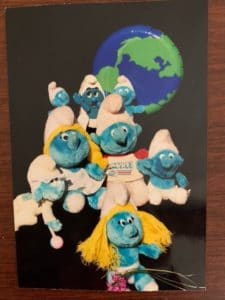
The Smurfs were a collection of over 100 humanoids and they lived in mushroom houses in Smurf Village. The strange creatures were three apples tall, blue and white, and their leader was Papa Smurf who was 543 years old.
Originating in Belgium in 1958, the quirky Smurf cartoon strip was popular entertainment fare. The trendy cartoon had been enjoyed for many years by young and old alike for its always fresh and witty situations. It was clever and funny with a lovable group of silly characters called Smurfs. Seemingly, the audiences could not get enough of these cute turquoise and white pixie-like anthropomorphic gnomes. However, they took a long time to get to the United States, but when they arrived, a considerable number of the children of that time hopped on the bandwagon to Smurf Village. The animated Saturday morning television show debuted on NBC in 1981 and quickly became a huge success. The longevity of the program was unequaled. Taking the nation by storm, it was embraced right-off the bat, setting records for its massive popularity. It ran an unprecedented nine years, before ending in 1990 with an incredible 150 episodes to its credit. As most popular shows do, it eventually landed in re-run-ville for the many forthcoming generations to enjoy.
A number of changes were attributed to the show’s demise; Mainly a switch in venue nixed the already tired scene. The diluted new storyline affected a lot of fans’ loyalties and soon they were dropping off like dead flies. Of course, there will always be the proverbial diehards who will never give up on the Smurfs. They are fans for the duration, and collect Smurf stuff just for the sheer joy of it. To a collector, nostalgia reigns supreme and not because the show finally wore out its welcome. Smurf aficionados know the Smurfs will never die of old age, boredom or lack of collectability either. They live on via the Saturday morning cartoon reruns known as The Smurfs Adventures shown back in the 1990s, and in recent times shown on the Boomerang channel’s cartoon network.
Serious collectors might find old Smurf toys through the collectible online markets such as eBay, Craigslist, Etsy, etc. Or some are even found at garage sales, yard sales, estate sales or the vast number of thrift stores like Goodwill, Salvation Army, or a variety of antique shops throughout the nation-where one can find almost every toy ever made to add to their precious collection. But just so you know, on today’s secondary market Smurfs are rare and expensive and if you are lucky enough to bump into one somewhere, they will come at a premium price.
Since the Smurf’s arrival, there is barely a person in the world who wouldn’t remember that oddball turquoise and white imp with the protruding blue nose, and that “Dairy Queen” dollop white cap. There was only one girl Smurf for a long while and her name was Smurfette. She had thick, yellow braided yarn hair and otherwise looked just the same as her male counterpart. These amazing characters were goofy looking and whimsical dorks who lived a controversial lifestyle maybe because they lived in mushrooms, which raised a few eyebrows given the times. The Smurfs were the brainstorm of English/Belgium artist/writer Pierre Culliford AKA Peyo, ( 1928-1992). Peyo’s artistic career began in 1947 drawing serials for a Belgium newspaper. Peyo used the Smurfs in his renowned cartoon strip Johan and Pirlouit. They became so beloved by Peyo’s followers that he eventually made them a regular part of his strip.
Soon the fame of the Smurfs mushroomed into a toy figurine business. The PVC figurines manufactured by Schleich in 1960 were catching on quite famously-foremost in their own homeland and eventually and not so surprisingly everywhere around the globe. Those fundamental toys eventually germinated a ton of merchandise abroad, but it took some years before it actually happened here in America. At first only three figurines were manufactured: Normal Smurf, Gold Smurf, and Convict Smurf. It took until 1978 before the Smurfs found recognition in America. Finding the Smurfs hard to ignore, Hanna-Barbera, a cartoon animation production company, latched onto this sensational opportunity and the Smurf cartoons found a place among the stars. After the cartoon came out the reputation of the toys grew in epic proportions and 1980 saw the toys reach their pinnacle of success.
The Smurf toys (called Schtroumpfs in their homeland) came in various sizes and materials such as: fiber filled plush, beanbag plush, hard plastic, and PVC vinyl etc. and were produced by such companies as Schleich, Applause, Illco, Pez, Wallace Berrie, McDonalds, Ertl, Ohio Art, and Irwin. Their sizes ran the gamut from inches to feet. The most popular seller was the diminutive PVC figurine, probably because of their versatility. They could go anywhere, any place, anytime unnoticed. Teachers hated the little troublemakers. Like a muse in waiting, they were great little secret treasures dragged out of hiding during particularly boring situations. Perhaps this was part of their charm.
Who can forget Papa Smurf, and Smurfette, The Spy Smurf, Angry Smurf, and Drummer Smurf, Moon Smurf, Winter Smurf, Brainy Smurf, Guitar Smurf, Super Smurf, Skateboarder Smurf, American Football Smurf, Baseball Smurf and Cheerlead Smurf to name a few. What a wonderful time in history! Relatively innocent compared to today’s leniencies.
